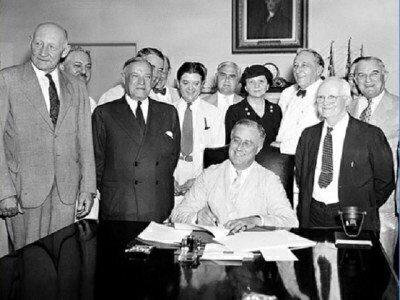It was on August 14, 1935 that President Franklin Roosevelt signed one of his most-sweeping New Deal programs into law, the Social Security Act. The act survived constitutional challenges to become a linchpin of retirement planning and a constant source of debate.
 Today, the political discussion over Social Security revolves around the potential solvency of various programs related to it. In 2015, more than 59 million retired Americans and nearly 9 million disabled people receive Social Security benefits that paid for by payroll taxes split between employees and employers.
Today, the political discussion over Social Security revolves around the potential solvency of various programs related to it. In 2015, more than 59 million retired Americans and nearly 9 million disabled people receive Social Security benefits that paid for by payroll taxes split between employees and employers.
The program’s trustees have reported that key parts of Social Security retirement and disability trust funds will be depleted in about two decades without changes approved by lawmakers. And any proposed changes to Social Security are political lightning rods.
But 80 years ago, Social Security’s creation was controversial at its birth and it took several Supreme Court rulings to guarantee the program’s survival.
Before the Great Depression, social-relief and retirement programs were strictly the business of the private sector, with exceptions such as veterans’ assistance. In 1933, a medical doctor and public official named Dr. Francis Townsend wrote a newspaper op-ed piece proposing a national government-sponsored retirement plan.
The idea gained attention quickly and an estimated 7,000 Townsend Clubs formed around the United States within two years, with more than 2 million members. While parts of Townsend plan were impractical, the idea of a national “safety net” program found a home in the Social Security Act.
President Roosevelt asked Congress to draft Social Security legislation in January 1935, and the House and Senate had extensive debates between April and June. It took until August 1935 to reconcile differences between the House and Senate versions, and the final Conference Report was passed by voice vote on August 8, 1935 in the House and on August 9th in the Senate.
At 3:30 p.m. on August 14, 1935, President Roosevelt signed the act into law at the White House Cabinet Room. But the fight over Social Security as part of the New Deal wasn’t over – and the act’s future was far from certain.
Parts of Roosevelt’s New Deal program had been challenged in court successfully. In May 1935, the Supreme Court invalidated a key part of the National Industrial Recovery Act, and also the Railroad Retirement Act. Roosevelt then started a very public feud with the Court that lasted for several years.
“We have been relegated to the horse-and-buggy definition of interstate commerce," Roosevelt told reporters on May 31, 1935.
In January 1936, the Supreme Court ruled the Agricultural Adjustment Act as unconstitutional. The act relied on an extensive ability to levy taxes for the general welfare as the basis for its price-support program – the same type of funding plan that was at the heart of the Social Security Act.
In February 1937, a frustrated Roosevelt threatened to ask Congress for the ability to nominate more Supreme Court Justices, in an effort to “pack” the Court with sympathetic votes. The Supreme Court then changed its course about the New Deal programs in three major rulings in the following months.
The third set of rulings involved the Social Security Act. In a 7-2 opinion, the Court upheld Social Security’s retirement pension provisions, while unemployment survived by a 5-4 vote.
“The hope behind this statute is to save men and women from the rigors of the poor house as well as from the haunting fear that such a lot awaits them when journey's end is near,” said Justice Benjamin Cardozo.






